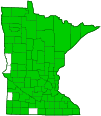purple loosestrife
(Lythrum salicaria)
Conservation • Weed • Wetland • Description • Habitat • Ecology • Use • Distribution • Taxonomy
Description |
||
Purple loosestrife is an erect, stout, perennial forb that rises on 30 to 50 stems from a taproot and shallow, fibrous roots that develop rhizomes. It can be 12″ to 72″ tall, though in Minnesota it is usually less than 48″ in height. The stems are erect, square, hairy within the inflorescence, variably hairy above the middle, hairless below. Mature plant stems may be 5- or 6-sided and woody near the base in late summer. The leaves are opposite below the inflorescence, sometimes alternate within the inflorescence. Sometimes they appear in whorls of 3. They are lance-shaped to nearly linear, 1″ to 4″ long, and 3 ⁄16″ to ⅝″ wide, becoming gradually smaller as they ascend the stem. They taper to a point at the tip and are rounded at the base. The larger leaves are somewhat heart-shaped at the base and slightly clasp the stem. The upper and lower surfaces are more or less softly hairy, especially those near the top of the stem. The margins are untoothed. The inflorescence is a dense, 6″ to 14″ long, spike-like cluster of numerous flowers at the end of the stem. The flowers are in whorled clusters rising from a pair of hairy, leaf-like bracts. The clusters have 1 or more stalkless flowers and there are 3 to 9 flowers per whorl. Individual flowers are ½″ to 1″ wide. There are 5 or 6, sometimes 7, pink to purple petals and the same number of green to purple sepals. The petals are about twice as long as the sepals. The petals are fused at their base with the sepals for most of the sepal length into a hairy, 12-nerved, 3 ⁄16″ to 5 ⁄16″ long, 1 ⁄16″ wide tube (hypanthium). There are always at least 10, usually 12, stamens, in 2 whorls of 5 or 6 each. There are three types of flowers, distinguished as those with short, medium, or long styles. Flowers with short styles have a whorl of long stamens and a whorl of medium length stamens. Flowers with medium-length styles have a whorl of long stamens and a whorl of short stamens. Flowers with long styles have medium to short stamens. The longer stamens protrude well beyond the tube. The fruit is a two-chambered capsule about ⅛″ long and 1 ⁄16″ in diameter containing many dust-like seeds. |
||
Height |
||
12″ to 72″ |
||
Flower Color |
||
Pink to purple |
||
Similar Species |
||
Fireweed (Chamerion angustifolium) stem is round. The leaves are alternate. The flower spike is 4″ to 5″ wide at the base. Swamp loosestrife (Decodon verticillatus) stems are usually arched and rooting at the tip, not erect. The leaves are usually in whorls of 3 or 4 and are on short leaf stalks. The flowers are in dense clusters in the upper leaf axils. Winged loosestrife (Lythrum alatum var. alatum), a native plant, is usually hairless. The middle and upper leaves are alternate. The flowers are smaller, ½″ across or less, and appear singly in the upper leaf axils. There are always fewer than 10 stamens per flower. |
||
Habitat |
||
Wet. Fens, marshes, meadows, shores, shallows. Full to partial sun. |
||
Ecology |
||
Flowering |
||
July to September |
||
Biological Control |
||
Several insects that are native to the historic range of purple loosestrife have been intentionally introduced into North America to control the spread of this invasive plant species. black-margined loosestrife beetle (Neogalerucella calmariensis) flower bud weevil (Nanophyes marmoratus) Goeze root-boring weevil (Hylobius transversovittatus) golden loosestrife beetle (Neogalerucella pusilla) |
||
Use |
||
|
||
Distribution |
||||
|
Sources |
|||
| 9/21/2022 | ||||
Nativity |
||||
Native to Europe, Asia, northern Africa, Australia, and the Indian subcontinent. Introduced and naturalized in North America. |
||||
Occurrence |
||||
|
||||
Taxonomy |
|||
| Kingdom | Plantae (Plants) | ||
| Division | Tracheophyta (Vascular Plants) | ||
| Subdivision | Spermatophytina (Seed Plants) | ||
| Class | Magnoliopsida (Dicots) | ||
Order |
Myrtales (Myrtles, Evening Primroses, and Allies) | ||
Family |
Lythraceae (lythrum) | ||
| Genus | Lythrum (lythrum loosestrifes) | ||
Subordinate Taxa |
|||
|
|||
Synonyms |
|||
Lythrum salicaria var. gracilior Lythrum salicaria var. tomentosum Lythrum salicaria var. vulgare |
|||
Common Names |
|||
purple loosestrife purple lythrum rainbow weed salicaire spiked loosestrife |
|||
Glossary
Clasping
Describing a leaf that wholly or partly surrounds the stem but does not fuse at the base.
Hypanthium
A cup-like tubular structure of a flower formed from the fused bases of sepals, petals, and stamens, that surrounds the pistil. Its presence is diagnostic of many families, including Rose, Gooseberry, and Pea.
Rhizome
A horizontal, usually underground stem. It serves as a reproductive structure, producing roots below and shoots above at the nodes.
Sepal
An outer floral leaf, usually green but sometimes colored, at the base of a flower.
Visitor Photos |
|||||
Share your photo of this plant. |
|||||
| This button not working for you? Simply email us at info@MinnesotaSeasons.com. Attach one or more photos and, if you like, a caption. |
|||||
Alfredo Colon |
|||||
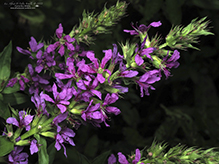 |
|||||
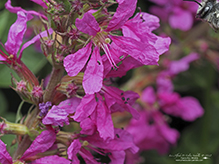 |
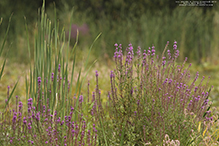 |
||||
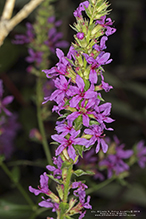 |
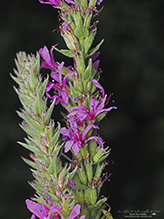 |
||||
Luciearl |
|||||
Not sure if this is Purple Loosestrife or a different type of Loosestrife |
|||||
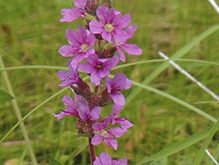 |
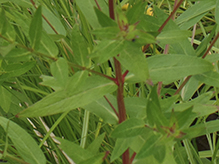 |
||||
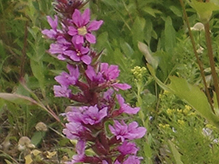 |
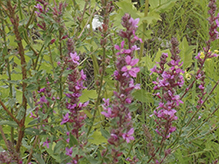 |
||||
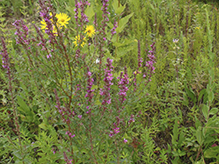 |
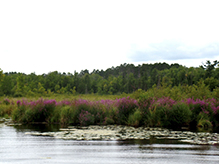 |
||||
This one includes inflorescence. |
|||||
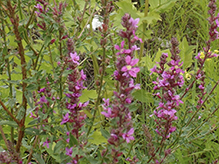 |
|||||
MinnesotaSeasons.com Photos |
|||||
Habitat |
|||||
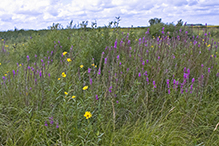 |
|||||
Plant |
|||||
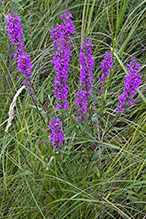 |
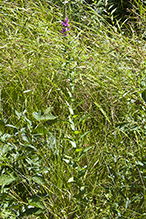 |
||||
Inflorescence |
|||||
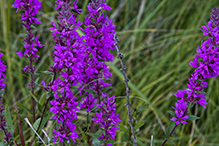 |
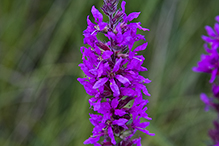 |
||||
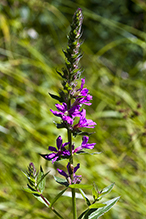 |
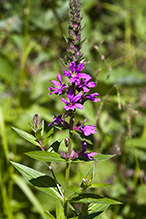 |
||||
Flower |
|||||
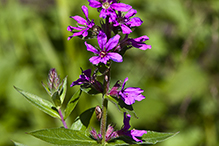 |
|||||
Leaves |
|||||
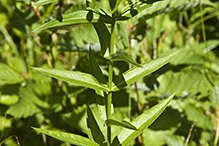 |
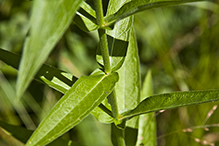 |
||||

Slideshows |
||
| Purple loosestrife Wez Smith |
||

|
||
About
Purple loosestrife (Lythrum salicaria). |
||
| Purple Loosestrife (Lythrum salicaria) Andree Reno Sanborn |
||
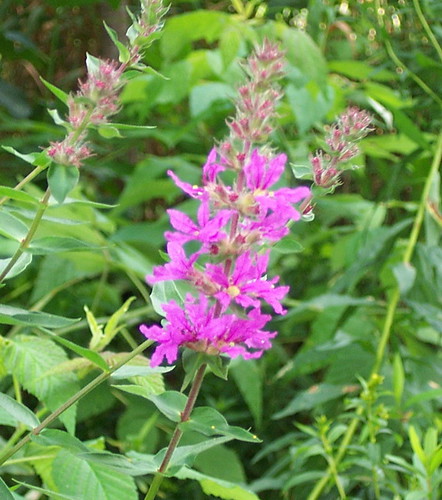
|
||
About
A very bad and beautiful plant. |
||
| Lythrum salicaria (Purple Loosestrife) Allen Chartier |
||
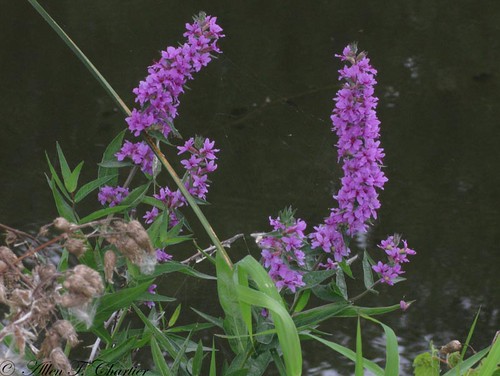
|
||

Visitor Videos |
|||
Share your video of this plant. |
|||
| This button not working for you? Simply email us at info@MinnesotaSeasons.com. Attach a video, a YouTube link, or a cloud storage link. |
|||
Other Videos |
|||
| Invaders in Our Waters - Purple Loosestrife invspecies |
|||
About
Published on Sep 27, 2012 Purple loosestrife is a wetland plant native to Europe and Asia that was brought to North Americain the early 19th century. This highly invasive plant was likely introduced when its seeds were included in soil used as ballast in European sailing ships and discarded in North America. For more information visit http://bit.ly/NTNm1z |
|||
| Purple Loosestrife: Beauty or Beast? Entomological Society of America |
|||
About
Uploaded on Feb 1, 2010 This educational video examines the invasive plant, Purple Loosestrife, and the effects it has on the environment. The New Jersey Department of Agriculture is using a beetle (Galerucella pusilla) to control the plant. Directed by Robert Balaam and Robert Chianese; produced by Dr. James Lashomb and Dr. George Hamilton; narrated by Joseph Ingerson-Mahar; filmed and edited by Jianxin Zhang and Hiten Pandya. |
|||
| Purple Loosestrife - A Very Wicked Plant Biophilia |
|||
About
Published on May 6, 2012 We made this video for the Wicked Plants display at the NC Arboretum. Watch all our wicked plant videos at: http://www.untamedscience.com/wickedplants |
|||

Visitor Sightings |
|||||
Report a sighting of this plant. |
|||||
| This button not working for you? Simply email us at info@MinnesotaSeasons.com. Be sure to include a location. |
|||||
| Alfredo Colon 8/4/2022 |
Location: Albany, NY |
 |
|||
| Alfredo Colon 8/2/2022 |
Location: Albany, NY |
 |
|||
| Alfredo Colon 8/31/2019 |
Location: Maplewood Nature Center |
 |
|||
| Luciearl 8/26/2019 |
Location: Upper Gull Lake, Spider Lake, Cass County |
 |
|||
| Luciearl 8/25/2019 |
Location: Lake Shore, Cass County Not sure if this is Purple Loosestrife or a different type of Loosestrife |
 |
|||
MinnesotaSeasons.com Sightings |
|||||

|
Created: Last Updated: © MinnesotaSeasons.com. All rights reserved. |
